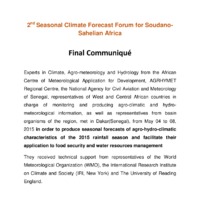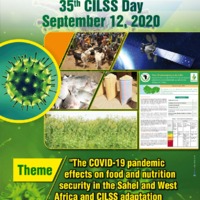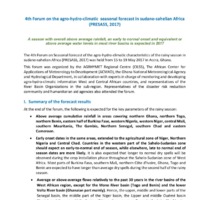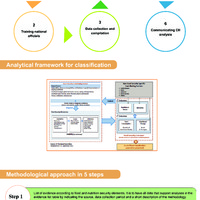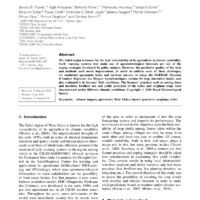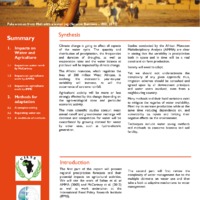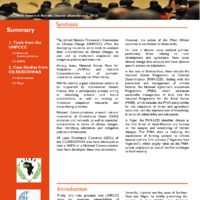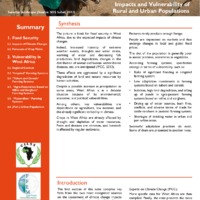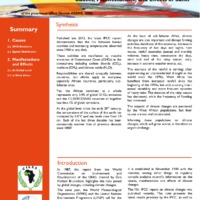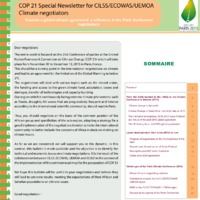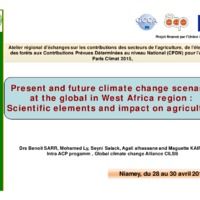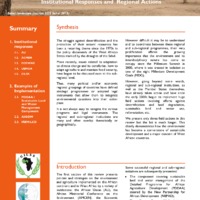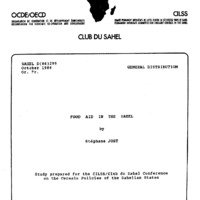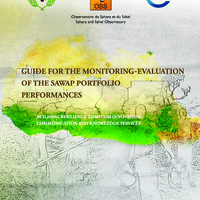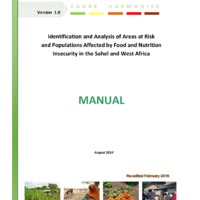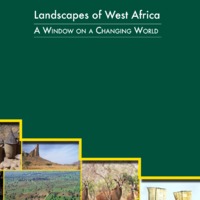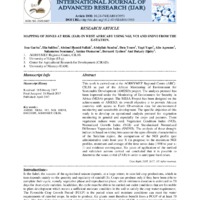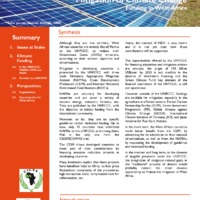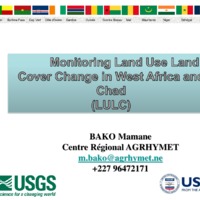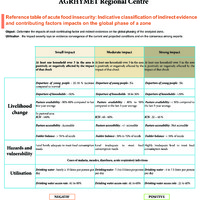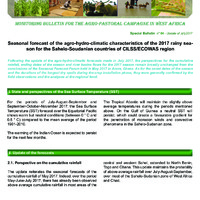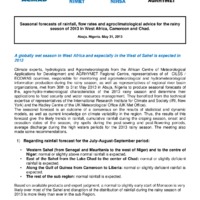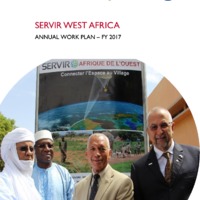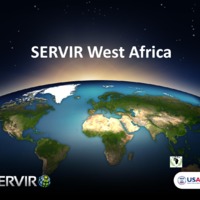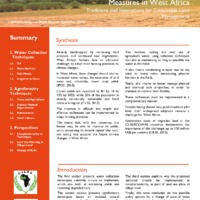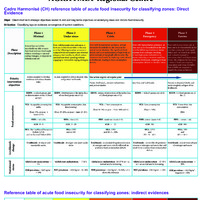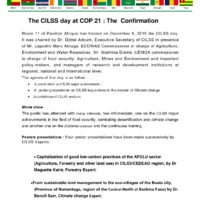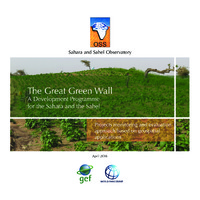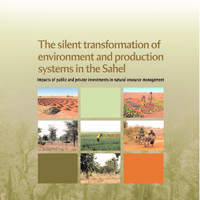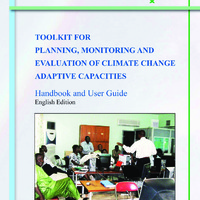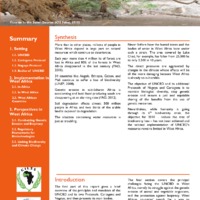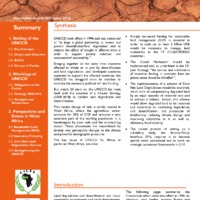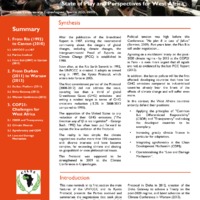Recherche
34 items
2nd Seasonal Climate Forecast Forum for Soudano- Sahelian Africa: Final Communiqué
Experts in Climate, Agro-meteorology and Hydrology from the African Centre of Meteorological Application for Development, AGRHYMET Regional Centre, the National Agency for Civil Aviation and Meteorology of Senegal, representatives of West and Central African countries in charge of monitoring and producing agro-climatic and hydrometeorological information, as well as representatives from basin organisms of the region, met in Dakar(Senegal), from May 04 to 08,
2015 in order to produce seasonal forecasts of agro-hydro-climatic characteristics of the 2015 rainfall season and facilitate their application to food security and water resources management
35th CILSS Day September 12, 2020
"The COVID-19 pandemic effects on food and nutrition security in the sahel and west Africa and CILSS adaptation efforts for information production"
4th Forum on the agro-hydro-climatic seasonal forecast in sudano-sahelian Africa (PRESASS, 2017)
A season with overall above average rainfall, an early to normal onset and equivalent or above average water levels in most river basins is expected in 2017.
Characterizing and modeling the diversity of cropping situations under climatic constraints in west africa
The Sahel region is known for the high vulnerability of its agriculture to climate variability. Early warning systems that make use of agrometerological forecasts are one of the coping strategies developed by policy makers. However, the predictive quality of the tools and methods used needs improvement. In order to address some of these challenges, we conducted agronomic trials and on-farm surveys to adapt the SARRAH (Syst`eme d’Analyse R´egionale des Risques Agroclimatiques, version H) crop simulation model, and also evaluated it in farmers’ field conditions. The farmers’ practices such as sowing dates and densities, fertilizer use and yields potentials of the millet and sorghum crops were characterized under different climatic conditions.
Climate change impacts on water and agriculture in west africa
Climate change is going to affect all aspects of the water cycle. The quantity and distribution of precipitation, the frequencies and duration of droughts, as well as evaporation rates and the water balance at plot level will be impacted by climate change. The African monsoon, which regulates the lives of 300 million West Africans, is evolving: the monsoon’s year-to-year variability will increase, as will the occurrence of extreme rainfall. Agricultural activity will be more or less strongly affected by this change depending on the agro-ecological zone and particular economic activity. The main scientific studies concur: mean annual runoff and groundwater recharge will decrease and competition for water will be exacerbated by growing demand for water by other uses, such as hydro-electric generation. Studies conducted by the African Monsoon Multidisciplinary Analysis (AMMA) are clear in stating that the variability in precipitation both in space and in time will be a real constraint on farm production. Society will need to adapt. Yet we should not underestimate the complexity of any given approach; thus, irrigation schemes should be consulted and agreed upon by all downstream principals and water users involved, even from a neighbouring country. Many methods and their local variations exist to mitigate the vagaries of water availability. Most try to increase production while at the same time reducing dependence on, and vulnerability to, inputs and limiting their negative effects on the environment. Techniques include water saving methods and methods to conserve biomass and soil fertility.
Climate change responses from west african states
The United Nations Framework Convention on Climate Change (UNFCCC) offers the developing countries some tools to evaluate their vulnerabilities to climate changes, to plan and to implement adaptation and mitigation policies and measures. Among them, National Action Plans for Adaptation (NAPAs) and National Communications are of particular importance, especially for West Africa. NAPAs identify urgent adaptation actions to be supported by international climate finance, after a participatory process aiming at identifying present and future vulnerabilities, as well as existing or innovative adaptation measures, and hierarchizing priorities. National Communications present national inventories of Greenhouse Gases (GHG) emissions and removals, as well as countries’ vulnerabilities in terms of climate changes, thus identifying adaptation and mitigation policies and measures. All Least Developed Countries (LDCs) of the CILSS/ECOWAS area have developed at least a NAPA or a National Communication; most have developed these two documents. However, the action of the West African countries is not limited to these tools. For over a decade, many national policies, particularly those relating to rural development and agriculture, have taken climate change into account and have planned specific actions on adaptation. In the case of Burkina-Faso, these include the National Action Programme to Combat Desertification (PAN-LCD), dealing with the prevention and management of climate hazards, the National Agriculture Investment Programme (PNIA) which addresses sustainable management of land, and the National Programme for the Rural Sector (PNSR), which includes the PNIA and provides for the adaptation of forest and agricultural resources, and the improvement of knowledge in terms of vulnerability and adaptation. In Niger, the PAN-LCD identifies climate as the first driver of desertification and focuses on the analysis and monitoring of climate changes. The PNIA aims at reducing the dependence of farming systems to climate hazards and the 3-N initiative ("Nigeriens feed Nigeriens"), which largely relies on the PNIA, quotes adaptation as one of the five challenges to food security.
Climate changes and food security impacts and vulnerability of rural and urban populations
The picture is bleak for food security in West Africa, due to the expected impacts of climate changes. Indeed, increased intensity of extreme weather events, droughts and water stress, warming of water and decreasing fish production, land degradation, changes in the distribution of animal and human vector-borne diseases, etc. are anticipated (IPCC, 2013). These effects are aggravated by a significant degradation of land and natural resources by human activities. Despite a possible increase in precipitation in some areas, West Africa is in a delicate situation because of its environmental, economic, and political vulnerabilities. Among others, key vulnerabilities are dependence on agriculture, low incomes, and the already significant variability in climate. Crops in West Africa are already affected by drought and depletion of water resources. Pests and diseases are common, and livestock is affected by regular outbreaks. Pastures rarely produce enough forage. People are dependent on markets and thus undergo changes in local and global food prices. The diet of the population is generally poor in animal proteins, sometimes in vegetables. According farming systems, specificities emerge in terms of vulnerability, such as: • Risks of significant flooding in irrigated farming system; • Low adaptation investments in farming systems based on tubers and cereals; • Isolation, high land degradation, and silting up of ponds in agro-pastoral farming systems based on millet and sorghum; • Drying up of water sources, bush fires, conflicts, and adverse terms of trade for cattle ranchers in pastoral farming system; • Shortages of drinking water in urban and peri-urban areas. Successful adaptation practices do exist. Some of them are presented in another note
Climate changes causes, manifestations, and effects in sahel
Published late 2013, the latest IPCC report demonstrates that the link between human activities and increasing temperatures observed since 1950 is very likely. These activities are manifested by massive emissions of Greenhouse Gases (GHGs) in the atmosphere, including carbon dioxide (CO2), methane (CH4), and nitrous oxide (N2O). Responsibilities are shared unequally between countries, but effects apply to everyone, especially African countries, particularly subSaharan ones. Yet, the African continent as a whole represents only 3.4& of global GHGs emissions and the CILSS/ECOWAS countries all together less than 1& of global emissions. At the global level, since the early 20th century, the temperature of the surface of the earth has increased by 0.8°C and sea levels rose from 19 cm. Each of the last three decades has been successively warmer than all previous decades since 1850! At the level of sub-Saharan Africa, climate changes are also important and disrupt farming activities, backbone of the economy: increase in the frequency of hot days and nights, heat waves, rainfall anomalies (annual and monthly volumes, heavy rains, consecutive dry days, start and end of the rainy season, etc.), increase in extreme weather events, etc. The example of the rainfall is striking: after experiencing an unprecedented drought in the world since the 1970s, West Africa has benefited from increased rainfall since the beginning of the 1990s, but with a strong interannual variability and more frequent episodes of heavy rains. The duration of the rainy season has decreased, while the frequency of flooding has increased. The impacts of climate changes are perceived by the West African populations, but their causes are not well understood. Informing these populations on climate changes, which will grow worse, is therefore an urgent challenge.
COP 21 Special Newsletter for CILSS/ECOWAS/UEMOA Climate negotiators Towards a global climate agreement: a milestone in the Paris Conference negotiations
Le programme régional « Alliance Mondiale contre le Changement Climatique » (AMCC/GCCA) de l’espace CILSS/CEDEAO est une initiative du groupe Afrique-Caraïbes-Pacifique (ACP) financée par l’Union Européenne. Il vise, entre autres, à renforcer les capacités des pays de la sous-région sur les principaux enjeux liés aux négociations sur le climat. Ce bulletin est principalement destiné aux négociateurs, aux décideurs, à la société civile, aux ONG de l’espace CILSS/CEDEAO, mais aussi à tout lecteur interpellé par la question des changements climatiques. Cet espace dispose, en effet, d’une faible masse critique de négociateurs. Ce bulletin fait le bilan des négociations depuis la Convention de Rio (1992) jusqu’aux Accords de Doha (2012), en passant par la feuille de route de Bali (2007), l’Accord de Copenhague (2009), les Accords de Cancun (2010), le lancement de la Plateforme de Durban (2011). Il présente aussi les enceintes de négociations, les pays et groupes de pays en présence, les principales positions de négociation, les outils du négociateur. Ce bulletin met aussi en relief les points d’achoppement et de blocage des négociations. On insiste notamment sur les engagements des pays développés, la dichotomie entre pays Annexe 1 et pays non Annexe 1, la place des grands pays émergents (Chine Brésil, Inde, etc.), le principe de responsabilité commune mais différencié, etc. Le bulletin démontre également que l’effort global de réduction s’est réduit sur la 2ème période du Protocole de Kyoto 2013-2020 par rapport à 2008-2012. Le niveau d’ambition actuel est trop faible pour espérer rester sous les +2°C et éviter un dérèglement climatique annoncé par le GIEC. Un des points saillants de ce bulletin est le décryptage de l’agenda et des enjeux de la COP19 qui se tiendra du 11 au 22 novembre 2013 à Varsovie. Les principaux points des agendas (COP19, CMP9, SBSTA39, SBI39, ADP2-3) sont classés selon les cinq piliers du plan d’action de Bali à savoir la vision partagée, l’atténuation, l’adaptation, le transfert de technologies et le financement. Le premier point fera a priori l’objet de discussions intenses face aux blocages des négociations sur les engagements d’atténuation. Les positions du groupe Afrique issue de la Déclaration de Gaborone sur le changement climatique lors de la cinquième session extraordinaire de la Conférence ministérielle africaine sur l’environnement sont également présentées. Au regard de la position du groupe Afrique, des orientations spécifiques de négociations ont été identifiées pour l’espace CILSS/CEDEAO par les participants de l’atelier de préparation de la COP19 organisé par le CILSS en octobre 2013 à Ouagadougou. Enfin, le bulletin décrit le rôle et la place du CILSS en tant qu’institution régionale spécialisée sur le climat dans l’appui et l’accompagnement des négociateurs ouest africains
CPDN Session4présentationimpactagricra
Present and future climate change scenario at the global in West Africa region : Scientific elements and impact on agriculture
Desertification and climate change institutional responses and regional actions
The struggle against desertification and the protection of their natural resources has been a recurring theme since the 1970s in the policy documents of the West African States marked by the droughts of the Sahel. More recently, issues related to adaptation to climate change and its corollaries, how to adapt agriculture and maintain food security, have begun to be discussed even at the subregional level. Thus, many political and/or economic regional groupings of countries have defined strategic programmes or adopted legal instruments that allow them to integrate environmental questions into their action plans. It is not always easy to navigate the various programs and legal instruments. The regional and sub-regional institutions are many and often overlap thematically or geographically. Introduction The first section of this review presents policies and strategies on the environment and agriculture implemented on the African continent and in West Africa by a variety of institutions: the African Union (AU), the African Ministerial Conference on the Environment (AMCEN), the Economic Community of West African States (ECOWAS), the West African Economic and Monetary Union (UEMOA), and the Permanent Interstates Committee for Drought Control in the Sahel (CILSS). However difficult it may be to understand and to coordinate between these regional and sub-regional programmes, their very proliferation affirms the growing importance that the environment and its interdisciplinary nature has come to occupy since the Millenium Summit in 2000, where it was treated in isolation as one of the eight Millenium Development Goals (MDG). However, going beyond mere words, regional and sub-regional institutions, as well as the Member States themselves, have already taken action and have since the early 2000s begun to implement huge field actions involving efforts against desertification and land degradation, sustainable land and water use, reforestation, etc. We present only three field actions in this review but the list is much longer. This clearly demonstrates how the environment has become a cornerstone of sustainable development and a major concern of West African countries
Identification and Analysis of Areas at Risk and Populations Affected by Food and Nutrition Insecurity in the Sahel and West Africa
Facing recurrent food and nutrition insecurity affecting Sahelian and West African populations, governments and their development partners have set up mechanisms to monitor food situation. However, these mechanisms do not use the same methodological approaches, which often lead to results that are difficult to compare and which at times are even contradictory. Aware of this situation and the need to find a suitable solution, CILSS member states and partners have initiated the development of a Cadre harmonisé d’identification et d’analyse des zones à risque et des populations en insécurité alimentaire et nutritionnelle au Sahel et en Afrique de l’Ouest (Harmonized Framework for Identification and Analysis of Areas at Risk of and Populations Affected by Food and Nutrition Insecurity in the Sahel and West Africa). This tool, known as “Cadre Harmonisé” (CH), is expected to serve as a framework for countries to assess food and nutrition insecurity on an objective and consensual basis. The purpose of the Cadre Harmonisé is to help countries prevent food crises better and, where appropriate, quickly identify affected populations and appropriate measures to improve their food and nutrition security. The related method has been developed by a group of food and nutrition security experts from CILSS, FAO, WFP, FEWS NET, AFD, IPC/GSU, JRC/EC and UNICEF, and from international NGOs Oxfam International, Save the Children and ACF1. It is worth recalling that starting from 2008, various meetings held by the CH Technical Committee agreed for the CH to include some elements of the Integrated Food Security Phase classification version 1 (IPC 1.0). The IPC is a set of tools and procedures for classifying food and nutrition insecurity severity for decision making. Since the development of a manual for IPC 2.0, discussions have been under way to bring the CH closer to the IPC to incorporate lessons learned that improve comparability of results from the two tools. Similar to the IPC, the Cadre Harmonisé seeks to make best use of a set of tools and procedures for classifying the nature and severity of current and projected food and nutrition insecurity situations on the basis of a consensual analytical framework and classification scale. The CH is based on the following four conceptual models commonly used by national, regional and global mechanisms: Risk = f (Hazard, Vulnerability) Sustainable Livelihoods Framework The UNICEF Nutrition Conceptual Framework The four dimensions of food security (availability, access, utilization, and stability) The CH therefore is an integrated analytical framework built on a technical consensus that seeks to make best use of data from all systems or methods, namely food consumption surveys, nutrition surveys, the Household Economy Approach (HEA) or other information provided by agricultural surveys and market monitoring. The CH assesses food and nutrition insecurity, based on convergence of evidence from several indicators. The CH uses a food insecurity severity scale with five phases. Such a severity scale, which is an international one, makes it possible to make comparisons between countries of the sub-region and also at global level. CILSS was mandated to develop and implement the CH as a common tool for Sahelian and West African countries. Its analysis cycles will from now on help develop regional mapping of current food and nutrition situations and analyze projected situations. 1 Other institutions such as MIFRAC, IBIMET and CARE International initially contributed to the development of the present analytical framework. Cadre Harmonisé MANUAL Version 1.0 Page | 13 The CH also seeks to strengthen the regional integration framework in the CILSS-ECOWAS-UEMOA region so that collaborative and harmonized analyses of food and nutrition situations are conducted through the best possible use of other tools and analysis methods developed by national mechanisms and partners. Given the importance of the process of harmonizing the analytical framework for food and nutrition situations in West Africa, it is necessary that all food and nutrition security stakeholders take ownership of it and make it their decision-making tool. Furthermore, efforts are needed to strengthen the partnership framework within countries and to support the operations of early warning systems in order to improve the collection of reliable data. CH implementation relies on existing data collection mechanisms. Efforts should be made by countries and partners to provide financial support to these mechanisms - as CH implementation will from now on be the baseline reference for activating regional food reserves and mobilizing technical and financial partners (TFPs).
Landscapes of west africa : a window on changing world
Beyond raising awareness, the atlas also aims to incite action to protect the environment of West Africa and the Sahelian region. We therefore invite everyone — scientists, students, researchers, teachers, planners, managers of development or research projects, local, national and regional decision-makers, donors, members of civil society organizations, and visitors to the region — to make the most of this work.
Mapping of zones at risk in west Africa by using NGI, VCI and SNDVI from the E-Station.
This work is carried out at the AGRHYMET Regional Centre (ARC)-CILSS as part of the African Monitoring of Environment for Sustainable Development (AMESD) project. The analysis protocol has been improved under the Monitoring of Environment for Security in Africa (MESA) project. The MESA Project has been designed on the achievements of AMESD; its overall objective is to provide African countries with access to Earth Observation data for environmental monitoring and sustainable development. The specific objective of this study is to develop an operational analysis protocol for vegetation monitoring in general and especially for crops and pastures. Three vegetation indices were used: Vegetation Condition Index (VCI), Normalized Growth Index (NGI) and Standardized Normalized Difference Vegetation Index (SNDVI). The analysis of these drought indices is based on taking into account the agro-climatic characteristics of the Sahelian region, the comparison of the NGI profile (per administrative unit) from year X (in progress) to the maximum NGI profiles, minimum and average of the time series data (1998 to year x-1) and evidence convergence. Six years of application of the method and validation actions carried out concluded that it is possible to determine the zones at risk (ZAR) in order to anticipate food crises.
Mitigation of climate change funding in west africa
Although they are low emitters, West African countries are invited, like all Parties to the UNFCCC, to reduce their Greenhouse Gases (GHGs) emissions, according to their national capacities and circumstances. Mitigation in developing countries is promoted by the UNFCCC with three tools: Nationally Appropriate Mitigation Actions (NAMAs), Clean Development Mechanism (CDM), and Intended Nationally Determined Contributions (INDCs). NAMAs are voluntary for developing countries and can cover a variety of sectors: energy, transport, forestry, etc. They are published by the UNFCCC, with the objective to attract funding from the international community. However, so far, they are no specific guidelines neither dedicated funding. Up to now, only 15 countries have submitted NAMAs to the UNFCCC, and among them, Mali is the only one from the CILSS/ECOWAS area. The CDM allows developed countries to meet part of their commitments by financing emission reduction projects in developing countries. Many limitations explain that these projects have benefited little to Africa: carbon price fluctuations, complexity of the procedures, high transaction costs, complicated rules for reforestation, etc. Finally, the concept of INDC is very recent and it is not yet clear how these contributions will be supported. The opportunities offered by the UNFCCC for financing adaptation and mitigation actions are tenuous: the target of 100 billion US$/year by 2020 is not credible in the absence of short-term financing and the Green Climate Fund, key element of the financial mechanism of the UNFCCC, is still not operational. However, outside of the UNFCCC, fundings are available for mitigation, especially in the agriculture and forest sectors: Forest Carbon Partnership Facility (FCPF), Forest Investment Programme (FIP), Global Alliance against Climate Change (GCCA), International Climate Initiative of Germany (ICI), and Japan Initiative for Fast-Start Actions. In the short term, the West African countries could better benefit from the CDM, by advocating for its adaptation to their national circumstances, as well as from the NAMAs, by requesting the development of guidelines and dedicated funding. In the medium and long term, in the absence of tangible prospects under the UNFCCC, the integration of mitigation-related goals in the "traditional" projects of donors would probably remain the most obvious opportunity to finance the mitigation in West Africa.
Seasonal forecast of the agro-hydro-climatic characteristics of the 2017 rainy season for the Sahelo-Soudano countries of CILSS/ECOWAS region
Following the update of the agro-hydro-climatic forecasts made in July 2017, the perspectives for the cumulative rainfall, ending dates of the season and river basins flows for the 2017 season remain broadly unchanged from the conclusions of the Seasonal Forecast Forum held in May 2017 in Accra, Ghana. As for the onset dates of the season and the durations of the longest dry spells during the crop installation phase, they were generally confirmed by the field observations and the analyses at the regional level.
Servir west africa annual work plan – fy 2017
On March 21, 2016, USAID awarded Tetra Tech a five-year contract to support the Agrometeorology, Hydrology and Meteorology Regional Center (AGRHYMET) in the implementation of SERVIR West Africa. The goal of SERVIR West Africa (SERVIR WA) is to increase the ability of institutions across the region to apply geospatial technologies and analysis to improve the region’s resilience to climate change impacts and ensure that land use management reduces greenhouse gas (GHG) emissions. The program supports the Permanent Interstate Committee for Drought Control in the Sahel (CILSS)/AGRHYMET’s ability to increase the supply of geospatial information and knowledge products and services for resilient and low carbon development to member countries in food security and agriculture; water and water-related disasters; land cover and land use change and ecosystems; and weather and climate. To support this goal, SERVIR WA has the following program objectives:
Servir west africa-ppt niger 17 may 2016
Endorsed by USAID and NASA leadership: 1.Reach More Users with Demand-Driven Products and Services 2.Connect More Innovative and Appropriate Science to SERVIR 3.Expand SERVIR Networks through New Strategic Partnerships 4.Improve Sustainability of SERVIR at Multiple Levels
Successful adaptation strategies and measures in west africa traditions and innovations for sustainable land management
Already handicapped by increasing land pressure and continued land degradation, West African farmers face an additional challenge: to adapt their farming practices to climate changes. In West Africa, these changes should lead to increased water stress, the extension of arid areas and, ultimately, lower crop yields (IPCC, 2013). Cereal yields are expected to fall by 10 to 15& by 2025, while 20& of the population is already structurally vulnerable and food crises are regular (CILSS, 2013). The situation is difficult, but simple and effective techniques can be implemented to adapt farming practices. This means that, with few resources, the farmer may be able to improve its yields, while preserving its natural capital (the soil), and taking into account the future climate changes in West Africa. This involves making the best use of agricultural water, using collection techniques that aim at maintaining as long as possible the water in the fields. It also means combatting erosion due to the wind or heavy rains, introducing physical barriers in the fields. Finally, this implies to better manage physical and chemical soils properties, in order to maintain or restore their fertility. These techniques must be implemented in a complementary manner. Despite having shown very good results at plot level, their widespread adoption remains a challenge for West Africa. Restoration costs of degraded land in the CILSS/ECOWAS countries demonstrate the importance of this challenge: up to 100 million US$ per country (CILSS, 2013)
The cilss day at cop 21 : the confirmation
Posters presentations : Four poster presentations have been made successively by CILSS Experts: Capitalization of good low-carbon practices of the AFOLU sector (Agriculture, Forestry and other land use) in CILSS/CEDEAO region, by Dr Maguette Kairé, Forestry Expert; From sustainable land management to the eco-villages of the Boala city, (Province of Namentega, region of the Central-North of Burkina Faso) by Dr. Benoît Sarr, Climate change Expert; CILSS platform in the field of climate change and sustainable land management, by Dr. Issaka Lona, climate change expert; Scaling of smart agriculture for food security in the Sahel, Dr. Edwige Botoni, Natural Resource Management Expert;
The great green wall a development programme for the sahara and the sahel
The Great Green Wall Initiative (GGW) was launched in Africa at the Summit of Heads of State and Government held in Burkina Faso in June 2005. Designed first to serve as a means to combat desertification and poverty, the initiative was initially limited to the establishment of a “green belt” of trees extending from Senegal to Djibouti.
Toolking for planing, monotorin and evaluation of climate change adaptive capacities
Climate change is among the most serious threats confronting every person on the entire planet, and African populations are particularly vulnerable. All livelihoods suffer from the isolated or combined effects of many climate hazards that can negatively affect their productivity, and consequently food security and populations’ living conditions. Therefore, seeking to reduce the harmful effects of climate hazards relates directly to the fight against poverty. Reducing poverty and promoting human development depend in part on the reduction of greenhouse gas concentration in the atmosphere to prevent climate change (mitigation). But given that climate change is already happening and will continue to do so because of current and still-rising levels of carbon dioxide (CO2) in the atmosphere, it is also necessary to develop robust ways for natural and human systems to adjust in the face of future climate change effects (adaptation). Discussions on climate change now recognize that in addition to efforts to mitigate the phenomenon, strategies to enhance adaptation are a priority. This recognition has led to the unprecedented proliferation of many initiatives (projects, programs and policies) that relate climate change to development efforts. These initiatives, however, have so far hardly generated the expected outcomes. The disappointing results are due, in part, to the approaches and tools that were used to identify, plan, monitor and evaluate the initiatives. A study undertaken by the United Nations Economic Commission for Africa (Somda, 2010) on the shortcomings in the fields of monitoring and evaluation shows that these approaches are not sufficiently harmonized; they do not permit the drawing of consistent lessons that could improve the relevant formulation and implementation of new initiatives for climate change adaptation. This publication aims to resolve this issue by offering insights into harmonized approaches and tools for identifying, planning, monitoring and evaluating climate change adaptive capacities. It presents the theoretical approach and includes a practical users’ guide intended for development professionals, researchers and policy-makers. It contains a toolkit that harmoniously combines a number of existing approaches and tools for use at various intervention scales, and in this way defines a vision and a behavioural change strategy that are essential in the climate change adaptation process.
United nations convention on biological diversity (uncbd) state of play and perspectives for west africa
More than in other places, millions of people in West Africa depend in large part on natural resources which continue to deteriorate. Each year more than 4 million ha of forest are lost in Africa and 80& of the forests in West Africa disappeared in the last century (FAO, 2010). 34 countries like Angola, Ethiopia, Gabon, and Mali continue to suffer a loss of biodiversity (UNEP, 2008). Genetic erosion in sub-Saharan Africa is accelerating and local food-producing seeds are disappearing at an alarming rate (FAO, 2012). Soil degradation affects almost 500 million people in Africa and two thirds of the arable land is exposed to degradation. The situation concerning water resources is just as troubling. Introduction The first part of this report gives a brief overview of the principles and mandates of the UNCBD and its two Protocols, Cartagena and Nagoya, and then presents its main bodies. The second section introduces how far the UNCBD has been implemented and discusses specific aspects of agrodiversity and bio-security in the African context, then at the sub-regional West African level, and finally at the level of the individual countries of West Africa. Never before have the humid zones and the bodies of water in West Africa been under such a strain. The area covered by Lake Chad, for example, has fallen from 25,000 ha to only 2,500 in 40 years. The direct pressures are aggravated by changes in the climate whose effects will be all the more damaging because West Africa is already so vulnerable. The objective of UNCBD and its additional Protocols of Nagoya and Cartagena is to maintain biological diversity, stop genetic erosion and ensure a just and equitable sharing of the benefits from the use of genetic resources. Nevertheless, while humanity is going through its 6th biodiversity crisis, the objective for 2010 – reduce the rate of biodiversity loss – has not been achieved and the national implementation of UNCBD’s measures remains limited in West Africa.
United nations convention to combat desertification (UNCCD) : State of play and perspectives for west africa
UNCCD took effect in 1996 and was conceived of "to forge a global partnership to reverse and prevent desertification/land degradation and to mitigate the effects of drought in affected areas in order to support poverty reduction and environmental sustainability." Bringing together at the same time countries affected in whole or in part by desertification and land degradation, and developed countries expected to support the affected countries, the UNCCD has struggled since its creation to mobilise the necessary political will and funding. But, nearly 20 years on, the UNCCD has reset itself with the adoption of a 10-year Strategy (2008-2018) to combat land degradation and desertification. This recent change of tack is sorely needed in West Africa, where the agricultural sector accounts for 35& of GDP and occupies a very extensive part of the working population. It is handicapped by poor soils and the encroaching desert. These phenomena are exacerbated by already very perceptible changes to the climate and powerful demographic pressures. The key issues of UNCCD for Africa, in particular West Africa, are clear: Introduction Land degradation and desertification are major constraints to economic and social development. Inspired by that realisation, African, Latin American, and Mediterranean leaders called into being the UN Convention to Combat Desertification (UNCCD). Translation: Peter Gaechter, SOS Sahel Sharply increased funding for sustainable land management (SLM) is essential in order to scale up: at least 2 billion US$ would be necessary to manage land sustainably in the 17 CILSS/CEDEAO countries ; The Global Mechanism should be implemented and, as underlined in the 10year Strategy, “the sources and mechanisms of innovative funding, in particular from the private sector should be identified ”; The implementation of a scheme of Zero Net Land Degradation should be explored, which aims at compensating degraded land by an equal quantity of restored land and to achieve a balance. Indeed, this scheme would allow degraded land to be restored and contribute to combating degradation and desertification, the protection of biodiversity, reducing climate change, and improving adaptation to it, as well as, obviously, food security; The recent process of setting up a subsidiary body, the Science-Policy Interface (SPI), requires it to become quickly more operational and to work on strategic investment frameworks in SLM.
United nations framework convention on climate change (unfccc) state of play and perspectives for west africa
After the publication of the Brundtland Report in 1987, alerting the international community about the dangers of global changes, including climate changes, the Intergovernmental Panel of Experts on Climate Change (IPCC) is established in 1988. Soon after, at the Rio Earth Summit in 1992, the UNFCCC is created. It adopts an armed wing in 1997, the Kyoto Protocol, which enters into force in 2005. The first commitment period of the Protocol (2008-2012) did not address the issue, covering less than a third of global Greenhouse Gases (GHG) emissions and setting a modest target in terms of GHG emissions reduction (-5.2& in 2008-2012 compared to 1990). The opposition of the United States to any reduction of their GHG emissions ("The American way of life is not negotiable!" - George Bush, 1992) has often been put forward to explain the low ambition of the Protocol. The reality is less simple: the climate negotiations involve more than 190 countries with diverse interests and have become complex, far exceeding climate and abuting on geopolitical or even philosophical issues. This Protocol was supposed to be strengthened in 2009 at the Climate Conference in Copenhagen. Political tension was high before this Conference: "No plan B in case of failure" (Barroso, 2009). Five years later, the Plan B is still under negotiation... Agreeing on a multilateral treaty on the post2020 climate regime - by 2015 at the COP21 in Paris - is even more urgent that all signals are red, as evidenced by the last IPCC Report (2013). In addition, the last to pollute will be the first affected: developing countries that have low GHG emissions compared to industrialised countries already bear the brunt of the effects of climate change and will suffer even more. In this context, the West African countries ardently defend their positions: • Applying the principles of "Common But Differentiated Responsibility" (CBDR) and "Transparency" and asking the developed countries to be exemplary; • Increasing greatly climate finance in particular for adaptation; • Integrating agroforestry in the Clean Development Mechanism (CDM); • Operationalising the “Loss and Damage Mechanism”.
